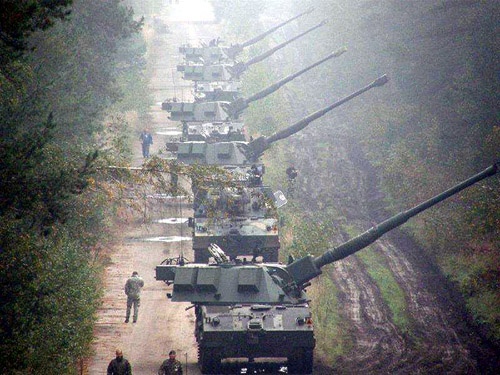Alguien sabe algo más sobre este obús del ejército norcoreano el M-1978 de 170mm
Les dejo un poco más de información:
M-1978 / M1989 (KOKSAN) 170mm self propelled (SP) gun
The M-1978 (KOKSAN) 170mm self propelled (SP) gun, of North Korean design and manufacture, is probably mounted on a T-54 chasis, a Chinese Type 59 hull or a T62 Chassis. The 170mm gun has no superstructure, and it has 2 large spades at the rear. The 170mm (~6.69") gun itself is a previously unknown type, possibly Russian coastal-defence or ex-naval weapon. The M-1978 Koksan gun was first noted publicly in a parade in 1985. The Koksan is named after the city in North Korea where it was first seen by the West in 1978. The M-1978 version carried no on-board ammunition supply.
The M1989 KOKSAN is a later version or modified M1978 which carries 12 rounds on-board ammunition supply. North Korea used them in batteries of 36 vehicles & supplied them to Iran when missiles became available as replacements.
During the Iran-Iraq War, key oil facilities of both nations were within artillery range of each other's armies. By June 1982, the Iraqis had been driven completely out of Iran. From that point on, Iraq spent most of the war on the defensive. In 1986 and the beginning of 1987, Iran launched new offensives, the last reaching the outskirts of Basra before again bogging down. Meanwhile, Iraq initiated a new tanker war in the Gulf, prompting Iran to target neutral shipping. Kuwait provided billions of dollars in loans and grants to support Iraq, and found itself in the middle of the combatants.
Iran acquired a number of M1978 Koksan guns from North Korea in 1987. "At that time, it was the longest-range field gun made anywhere in the world, capable of firing a rocket-assisted projectile to a range of almost 60 kilometers. It had been used by the Iranians to conduct harassment fire from the Al-Faw Peninsula into Kuwait's northeastern oil fields. With the Iran/Iraq War raging just to the north, fighting spilled over into Kuwait, and the steady pounding from the artillery barrages just to north shook the walls in Kuwait City.
Since 1993, the North has reinforced its artillery capability in the forward area. As of 1998 the South Korean military estimated that the DPRK had finished deploying 170mm self-propelled artillery with their range of over 50km and 240mm MRLS in the central and western areas, and was in the process of increasing deployment of these two weapons systems in the eastern area.
North Korea continues to improve its military. Highlighting these enhancements is an ambitious program to improve ground forces capabilities. A key component of this initiative involves the deployment of large numbers of long-range 240mm multiple rocket launcher systems and 170mm self-propelled guns to hardened sites located near the Demilitarized Zone. With the exception of the 170mm M-1978 Koksan gun, a new turreted self-propelled gun observed in a 1992 parade, and perhaps a few other systems, most artillery was developed from older Soviet and Chinese designs.
According to one report, a South Korean security analyst suggested that DPRK artillery pieces of calibers 170mm and 240mm "could fire 10,000 rounds per minute to Seoul and its environs." The number of Koksan guns is not publicly reported, but it is reliably reported that North Korea has about 500 long-range artillery tubes within range of Seoul, double the levels of a the mid-1990s. Large caliber self propelled artillery pieces typically have a sustained rate of fire of between four and eight rounds per minute. This suggests a total rate of fire of artillery alone of between 2,000 and 4,000 rounds per minute. The DPRK's two hundred 240mm MRLs fire either 12 or 22 rounds, providing a maximum single salvo of no more than 4,400 rounds.
North Korea is establishing a host of antitank defensive positions on the eastern and western fronts of the Demilitarized Zone (DMZ) that bisects the two Koreas. The North Korean army has been building antitank defensive positions north of the Military Demarcation Line (MDL) in Kangwon Province since March 2001, and in early 2002 such positions were going up along the western front as well. It is exceptional for the North to build defensive facilities as its strategy has always centered on an offensive posture. The North has demanded that South Korea abolish its defensive concrete walls, designed to deter advancing North Korean tanks, south of the MDL. By January 2002 fifty more positions had reportedly been spotted on flat land and roads, which ensure that tanks and other vehicles can be conveniently maneuvered. The positions are reportedly five meter-high concrete structures with holes at the front, left and right for antitank guns. The structures are camouflaged by earth and sand after completion.
Given North Korea's reliance on artillery as the foundation of their combat power and the size of these positions, they are likely designed for self-propelled artillery pieces such as north Korea's Koksan Gun. The height of the positions is much more then is required to provide protection for either tanks or anti-tank guns. Tanks are usually employed "hull down" in which only the turret is exposed and anti-tank guns which have little use against modern armor, normally seek to fire at the flank of armored vehicles at close range in restricted terrain. Anti-tank guns are of little value against the K-1 and M-60s of south Korea's military. North Korea's only realistic chance to take out modern armor is with the use of anti-tank missiles, mines, or close infantry assault.
Fuente :
http://www.globalsecurity.org/military/ ... 78-170.htm
































